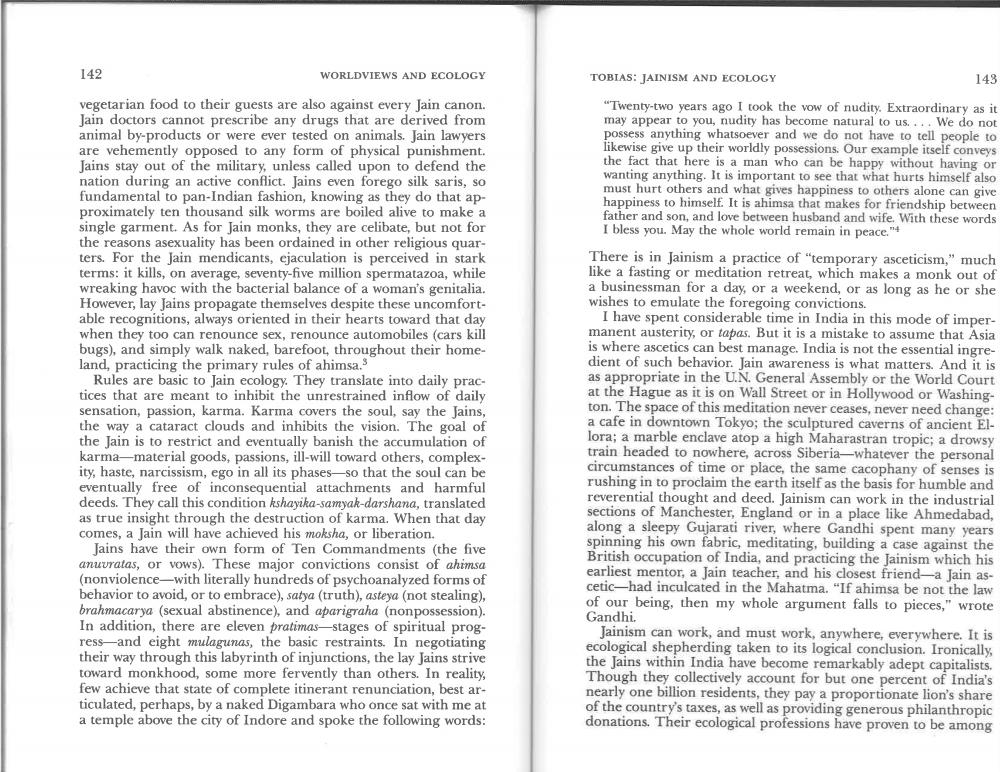Book Title: Jainism and Ecology Views of Nature Nonviolence and Vegeteranism Author(s): Michael Tobias Publisher: Michael Tobias View full book textPage 3
________________ WORLDVIEWS AND ECOLOGY vegetarian food to their guests are also against every Jain canon. Jain doctors cannot prescribe any drugs that are derived from animal by-products or were ever tested on animals. Jain lawyers are vehemently opposed to any form of physical punishment. Jains stay out of the military, unless called upon to defend the nation during an active conflict. Jains even forego silk saris, so fundamental to pan-Indian fashion, knowing as they do that approximately ten thousand silk worms are boiled alive to make a single garment. As for Jain monks, they are celibate, but not for the reasons asexuality has been ordained in other religious quarters. For the Jain mendicants, ejaculation is perceived in stark terms: it kills, on average, seventy-five million spermatazoa, while wreaking havoc with the bacterial balance of a woman's genitalia. However, lay Jains propagate themselves despite these uncomfortable recognitions, always oriented in their hearts toward that day when they too can renounce sex, renounce automobiles (cars kill bugs), and simply walk naked, barefoot, throughout their homeland, practicing the primary rules of ahimsa.3 142 Rules are basic to Jain ecology. They translate into daily practices that are meant to inhibit the unrestrained inflow of daily sensation, passion, karma. Karma covers the soul, say the Jains, the way a cataract clouds and inhibits the vision. The goal of the Jain is to restrict and eventually banish the accumulation of karma-material goods, passions, ill-will toward others, complexity, haste, narcissism, ego in all its phases-so that the soul can be eventually free of inconsequential attachments and harmful deeds. They call this condition kshayika-samyak-darshana, translated as true insight through the destruction of karma. When that day comes, a Jain will have achieved his moksha, or liberation. Jains have their own form of Ten Commandments (the five anuvratas, or vows). These major convictions consist of ahimsa (nonviolence with literally hundreds of psychoanalyzed forms of behavior to avoid, or to embrace), satya (truth), asteya (not stealing), brahmacarya (sexual abstinence), and aparigraha (nonpossession). In addition, there are eleven pratimas-stages of spiritual progress and eight mulagunas, the basic restraints. In negotiating their way through this labyrinth of injunctions, the lay Jains strive toward monkhood, some more fervently than others. In reality, few achieve that state of complete itinerant renunciation, best articulated, perhaps, by a naked Digambara who once sat with me at a temple above the city of Indore and spoke the following words: TOBIAS: JAINISM AND ECOLOGY 143 "Twenty-two years ago I took the vow of nudity. Extraordinary as it may appear to you, nudity has become natural to us.... We do not possess anything whatsoever and we do not have to tell people to likewise give up their worldly possessions. Our example itself conveys the fact that here is a man who can be happy without having or wanting anything. It is important to see that what hurts himself also must hurt others and what gives happiness to others alone can give happiness to himself. It is ahimsa that makes for friendship between father and son, and love between husband and wife. With these words I bless you. May the whole world remain in peace."4 There is in Jainism a practice of "temporary asceticism," much like a fasting or meditation retreat, which makes a monk out of a businessman for a day, or a weekend, or as long as he or she wishes to emulate the foregoing convictions. I have spent considerable time in India in this mode of impermanent austerity, or tapas. But it is a mistake to assume that Asia is where ascetics can best manage. India is not the essential ingredient of such behavior. Jain awareness is what matters. And it is as appropriate in the U.N. General Assembly or the World Court at the Hague as it is on Wall Street or in Hollywood or Washington. The space of this meditation never ceases, never need change: a cafe in downtown Tokyo; the sculptured caverns of ancient Ellora; a marble enclave atop a high Maharastran tropic; a drowsy train headed to nowhere, across Siberia-whatever the personal circumstances of time or place, the same cacophany of senses is rushing in to proclaim the earth itself as the basis for humble and reverential thought and deed. Jainism can work in the industrial sections of Manchester, England or in a place like Ahmedabad, along a sleepy Gujarati river, where Gandhi spent many years spinning his own fabric, meditating, building a case against the British occupation of India, and practicing the Jainism which his earliest mentor, a Jain teacher, and his closest friend-a Jain ascetic-had inculcated in the Mahatma. "If ahimsa be not the law of our being, then my whole argument falls to pieces," wrote Gandhi. Jainism can work, and must work, anywhere, everywhere. It is ecological shepherding taken to its logical conclusion. Ironically, the Jains within India have become remarkably adept capitalists. Though they collectively account for but one percent of India's nearly one billion residents, they pay a proportionate lion's share of the country's taxes, as well as providing generous philanthropic donations. Their ecological professions have proven to be amongPage Navigation
1 2 3 4 5 6
